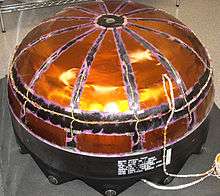Solar electric propulsion
.png)

_(4).jpg)
Solar electric propulsion typically refers to the combination of solar cells and ion drive for propelling a spacecraft through outer space.[1] This technology has been studied by NASA and is considered promising.[1] SEP is valued for its potential for a high specific impulse, thus allowing less mass for propellant to be launched with a spacecraft and it has been evaluated for mission to Mars.[2]
The main concept is a nexus of Solar panels on spacecraft and ion thruster. However, there are a number of other types of electrically powered spacecraft propulsion such as the Arcjet. It may not employ an ion drive, of which there are a variety of types also.
It is also possible to generate electricity from the Sun without using photovoltaic panels, such as with solar concentrators and a Stirling engine.
A 50 kw SEP system was studied in the 2010s for a mission to an asteroid.[3] In February 2012 NASA awarded a contract for a Solar Electric Propulsion Flight System .[4]
An example of work on this type of technology is Advanced Electric Propulsion System.[5]
The NASA Solar Technology Application Readiness (NSTAR) ion engine has been used with photovoltaic solar panels, which was tested on the Deep Space 1 mission along with Solar Concentrator Arrays (Launched in 1998 as part of the New Millennium Program) [6][7]
SEP has been studied as a technology for a mission to Mars.[8] In particular the high specific impulse of the ion engines could lower overall mass and avoid having to use nuclear technology for power when couple with solar panels.[9] A 1998 study for SEP for a human mission suggest that a human-sized spacecraft would need 600 to 800 kilowats of electrical power coupled with ion engines with a specific impulse of 2 to 2.5 thousand.[10]
Examples
- Hayabusa (launched)
- Deep Space 1 (launched)
- Dawn (spacecraft) (launched)
- Asteroid Redirect Mission (cancelled)
- Deep Space Gateway (planned)
- Psyche (spacecraft) (planned)
(may not be solar)
Electric propulsion technologies
- Resistojet rocket
- Ion thruster
- Pulsed plasma thruster
- Hall-effect thruster
- Magnetoplasmadynamic thruster
- Field-emission electric propulsion
- Variable Specific Impulse Magnetoplasma Rocket (VASMIR)
Category:Ion engines
See also
References
- 1 2 Mohon, Lee. "Solar Electric Propulsion (SEP)". NASA. Retrieved 2016-04-24.
- ↑
- ↑ "Solar Electric Propulsion: NASA's engine to Mars and Beyond - SpaceFlight Insider". www.spaceflightinsider.com. Retrieved 2018-07-28.
- ↑ "NASA Awards Solar Electric Propulsion Flight System Contract".
- ↑ "Advanced Electric Propulsion System successfully tested at NASA's Glenn Research Center - SpaceFlight Insider". www.spaceflightinsider.com. Retrieved 2018-07-28.
- ↑ "Advanced Technologies". NASA / Jet Propulsion Laboratory. Retrieved 20 November 2016.
- ↑ "In Depth | Deep Space 1 – Solar System Exploration: NASA Science". Solar System Exploration: NASA Science. Retrieved 2018-08-08.
- ↑
- ↑ [https://ntrs.nasa.gov/archive/nasa/casi.ntrs.nasa.gov/20050181421.pdf
- ↑